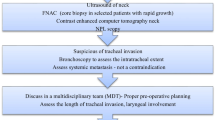Abstract
Thyroidectomy conventionally accompanies total laryngectomy. This study intends to analyze the incidence and factors leading to thyroid gland involvement in carcinoma larynx and hypopharynx. Retrospective chart review from March 2011 to December 2016 of all patients who had undergone total laryngectomy at our institute. A total of 125 patients entered into the analysis. Subsites involved were glottis (n = 32), supraglottis (n = 28), transglottis (n = 52), pyriform sinus (n = 12), and subglottis (n = 1). TNM distribution according to AJCC 7th edition is as follows: T2 (n = 1), T3 (n = 34), T4 (n = 90); N0 (n = 97), N1 (n = 13), N2a (n = 5), N2b (n = 5), N2c (n = 4), and N3 (n = 1). Total thyroidectomy was performed in 16 patients, near total thyroidectomy in 5, and hemithyroidectomy in 104. Histopathologically thyroid gland involvement was seen in 11/125 (8.8%). The overall incidence of hypothyroidism was 48% (hemithyroidectomy, 43/104; total thyroidectomy, 16/16; near total thyroidectomy, 1/5). The incidence of permanent hypoparathyroidism was 12.8% (total thyroidectomy, 11; hemithyroidectomy, 5). On multivariate analysis (Cox proportional hazards model), extralaryngeal spread into level 6 (HR = 5.5, p = .006, C.I = 1–18.8) and extracapsular extension (HR = 9.3, p = 0.02, C.I = 1.29–67.5) were statistically significant predictors for thyroid gland involvement. Survival analysis of patients with thyroid gland involvement (n = 11) revealed 5-year overall survival (OS) of 100% and 5-year disease-free survival (DFS) of 59.3% compared with patients without thyroid gland involvement, 71% and 51.7%, respectively (median follow-up, 30 months). Thyroid gland involvement did not show a statistically significant effect on OS/DFS on multivariate analysis. In view of the endocrine abnormalities and lack of survival benefit seen, thyroidectomy should be performed judiciously during total laryngectomy.


Similar content being viewed by others
References
Spector GJ, Sessions DG, Lenox J, Newland D, Simpson J, Haughey BH (2004) Management of stage IV glottic carcinoma: therapeutic outcomes. Laryngoscope 114(8):1438–1446
Sessions DG, Lenox J, Spector GJ, Newland D, Simpson J, Haughey BH et al (2002) Management of T3N0M0 glottic carcinoma: therapeutic outcomes. Laryngoscope 112(7 Pt 1):1281–1288
Gorphe P, Ben Lakhdar A, Tao Y, Breuskin I, Janot F, Temam S (2015) Evidence-based management of the thyroid gland during a total laryngectomy. Laryngoscope 125(10):2317–2322
Fagan JJ, Kaye PV (1997) Management of the thyroid gland with laryngectomy for cT3 glottic carcinomas. Clin Otolaryngol Allied Sci 22(1):7–12
Mendelson AA, Al-Khatib TA, Julien M, Payne RJ, Black MJ, Hier MP (2009) Thyroid gland management in total laryngectomy: meta-analysis and surgical recommendations. Otolaryngol Head Neck Surg 140(3):298–305
Kim JW, Han GS, Byun SS, Lee DY, Cho BH, Kim YM (2008) Management of thyroid gland invasion in laryngopharyngeal cancer. Auris Nasus Larynx 35(2):209–212
Biel MA, Maisel RH (1985) Indications for performing hemithyroidectomy for tumors requiring total laryngectomy. Am J Surg 150(4):435–439
Thorp MA, Levitt NS, Mortimore S, Isaacs S (1999 Apr) Parathyroid and thyroid function five years after treatment of laryngeal and hypopharyngeal carcinoma. Clin Otolaryngol 24(2):104–108
Lam KH (1983) Extralaryngeal spread of cancer of the larynx: a study with whole-organ sections. Head Neck Surg 5(5):410–424
Nayak SP, Singh V, Dam A, Bhowmik A, Jadhav TS, Ashraf M et al (2013) Mechanism of thyroid gland invasion in laryngeal cancer and indications for thyroidectomy. Indian J Otolaryngol 65(Suppl 1):69–73
Li SX, Polacco MA, Gosselin BJ, Harrington LX, Titus AJ, Paydarfar JA (2017) Management of the thyroid gland during laryngectomy. J Laryngol Otol 131(8):740–744
Harris AS, Passant CD, Ingrams DR (2018) How reliably can computed tomography predict thyroid invasion prior to laryngectomy? Laryngoscope 128(5):1099–1102
Mangussi-Gomes J, Danelon-Leonhardt F, Moussalem GF, Ahumada NG, Oliveira CL, Hojaij FC (2017) Thyroid gland invasion in advanced squamous cell carcinoma of the larynx and hypopharynx. Braz J Otorhinolaryngol 83(3):269–275
Kumar R, Drinnan M, Robinson M, Meikle D, Stafford F, Welch A et al (2013) Thyroid gland invasion in total laryngectomy and total laryngopharyngectomy: a systematic review and meta-analysis of the English literature. Clin Otolaryngol 38(5):372–378
Joo YH, Sun DI, Cho KJ, Cho JH, Kim MS (2010) The impact of paratracheal lymph node metastasis in squamous cell carcinoma of the hypopharynx. Eur Arch Otorhinolaryngol 267(6):945–950
de Bree R, Leemans CR, Silver CE, Robbins KT, Rodrigo JP, Rinaldo A et al (2011) Paratracheal lymph node dissection in cancer of the larynx, hypopharynx, and cervical esophagus: the need for guidelines. Head Neck 33(6):912–916
Simcock R, Simo R (2016) Follow-up and survivorship in head and neck cancer. Clin Oncol 28(7):451–458
de Bree R, Lips P, Leemans CR (2008) The need for patients’ endocrine function vigilance following treatment of head and neck cancer. Curr Opin Otolaryngol 16(2):154–157
Cinar U, Yiğit O, Alkan S, Uslu B, Topuz E, Unsal O et al (2003) [The effect of laryngectomy and postoperative radiotheraphy on thyroid gland functions]. Ear Nose Throat 10(6):226–230
Abd Elmaksoud AE, Farahat IG, Kamel MM (2015) Parathyroid gland autotransplantation after total thyroidectomy in surgical management of hypopharyngeal and laryngeal carcinomas: a case series. Ann Med Surg (Lond) 4(2):85–88
Author information
Authors and Affiliations
Corresponding author
Ethics declarations
Conflict of Interest
The authors declare that they have no conflict of interest.
Additional information
Publisher’s Note
Springer Nature remains neutral with regard to jurisdictional claims in published maps and institutional affiliations.
Rights and permissions
About this article
Cite this article
Panda, S., Kumar, R., Konkimalla, A. et al. Rationale behind thyroidectomy in total laryngectomy: analysis of endocrine insufficiency and oncological outcomes. Indian J Surg Oncol 10, 608–613 (2019). https://doi.org/10.1007/s13193-019-00935-4
Received:
Accepted:
Published:
Issue Date:
DOI: https://doi.org/10.1007/s13193-019-00935-4




